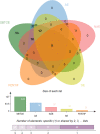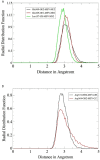Development of a Novel Multi-Epitope Vaccine Against Crimean-Congo Hemorrhagic Fever Virus: An Integrated Reverse Vaccinology, Vaccine Informatics and Biophysics Approach
- PMID: 34220816
- PMCID: PMC8242340
- DOI: 10.3389/fimmu.2021.669812
Development of a Novel Multi-Epitope Vaccine Against Crimean-Congo Hemorrhagic Fever Virus: An Integrated Reverse Vaccinology, Vaccine Informatics and Biophysics Approach
Abstract
Crimean-Congo hemorrhagic fever (CCHF) is a highly severe and virulent viral disease of zoonotic origin, caused by a tick-born CCHF virus (CCHFV). The virus is endemic in many countries and has a mortality rate between 10% and 40%. As there is no licensed vaccine or therapeutic options available to treat CCHF, the present study was designed to focus on application of modern computational approaches to propose a multi-epitope vaccine (MEV) expressing antigenic determinants prioritized from the CCHFV genome. Integrated computational analyses revealed the presence of 9 immunodominant epitopes from Nucleoprotein (N), RNA dependent RNA polymerase (RdRp), Glycoprotein N (Gn/G2), and Glycoprotein C (Gc/G1). Together these epitopes were observed to cover 99.74% of the world populations. The epitopes demonstrated excellent binding affinity for the B- and T-cell reference set of alleles, the high antigenic potential, non-allergenic nature, excellent solubility, zero percent toxicity and interferon-gamma induction potential. The epitopes were engineered into an MEV through suitable linkers and adjuvating with an appropriate adjuvant molecule. The recombinant vaccine sequence revealed all favorable physicochemical properties allowing the ease of experimental analysis in vivo and in vitro. The vaccine 3D structure was established ab initio. Furthermore, the vaccine displayed excellent binding affinity for critical innate immune receptors: TLR2 (-14.33 kcal/mol) and TLR3 (-6.95 kcal/mol). Vaccine binding with these receptors was dynamically analyzed in terms of complex stability and interaction energetics. Finally, we speculate the vaccine sequence reported here has excellent potential to evoke protective and specific immune responses subject to evaluation of downstream experimental analysis.
Keywords: Crimean-Congo hemorrhagic fever; Crimean-Congo hemorrhagic fever virus; immunoinformatics; molecular dynamics simulation; vaccine.
Copyright © 2021 Tahir Ul Qamar, Ismail, Ahmad, Mirza, Abbasi, Ashfaq and Chen.
Conflict of interest statement
The authors declare that the research was conducted in the absence of any commercial or financial relationships that could be construed as a potential conflict of interest.
Figures








Similar articles
-
In silico design and analyses of a multi-epitope vaccine against Crimean-Congo hemorrhagic fever virus through reverse vaccinology and immunoinformatics approaches.Sci Rep. 2022 May 24;12(1):8736. doi: 10.1038/s41598-022-12651-1. Sci Rep. 2022. PMID: 35610299 Free PMC article.
-
Immunization with DNA Plasmids Coding for Crimean-Congo Hemorrhagic Fever Virus Capsid and Envelope Proteins and/or Virus-Like Particles Induces Protection and Survival in Challenged Mice.J Virol. 2017 Apr 28;91(10):e02076-16. doi: 10.1128/JVI.02076-16. Print 2017 May 15. J Virol. 2017. PMID: 28250124 Free PMC article.
-
Nucleoside-Modified mRNA Vaccines Protect IFNAR-/- Mice against Crimean-Congo Hemorrhagic Fever Virus Infection.J Virol. 2022 Feb 9;96(3):e0156821. doi: 10.1128/JVI.01568-21. Epub 2021 Nov 24. J Virol. 2022. PMID: 34817199 Free PMC article.
-
Crimean-Congo hemorrhagic fever: current and future prospects of vaccines and therapies.Antiviral Res. 2011 May;90(2):85-92. doi: 10.1016/j.antiviral.2011.02.010. Epub 2011 Mar 6. Antiviral Res. 2011. PMID: 21362441 Review.
-
Recent advances in research on Crimean-Congo hemorrhagic fever.J Clin Virol. 2015 Mar;64:137-43. doi: 10.1016/j.jcv.2014.08.029. Epub 2014 Oct 22. J Clin Virol. 2015. PMID: 25453328 Free PMC article. Review.
Cited by
-
DNA Vaccines Encoding HTNV GP-Derived Th Epitopes Benefited from a LAMP-Targeting Strategy and Established Cellular Immunoprotection.Vaccines (Basel). 2024 Aug 19;12(8):928. doi: 10.3390/vaccines12080928. Vaccines (Basel). 2024. PMID: 39204051 Free PMC article.
-
Immunoinformatics and Biophysics Approaches to Design a Novel Multi-Epitopes Vaccine Design against Staphylococcus auricularis.Vaccines (Basel). 2022 Apr 19;10(5):637. doi: 10.3390/vaccines10050637. Vaccines (Basel). 2022. PMID: 35632394 Free PMC article.
-
Molecular Insights into Binding Mode and Interactions of Structure-Based Virtually Screened Inhibitors for Pseudomonas aeruginosa Multiple Virulence Factor Regulator (MvfR).Molecules. 2021 Nov 11;26(22):6811. doi: 10.3390/molecules26226811. Molecules. 2021. PMID: 34833903 Free PMC article.
-
Designing a Multi-Epitope Vaccine against Chlamydia trachomatis by Employing Integrated Core Proteomics, Immuno-Informatics and In Silico Approaches.Biology (Basel). 2021 Oct 3;10(10):997. doi: 10.3390/biology10100997. Biology (Basel). 2021. PMID: 34681096 Free PMC article.
-
The Role of Nucleocapsid Protein (NP) in the Immunology of Crimean-Congo Hemorrhagic Fever Virus (CCHFV).Viruses. 2024 Sep 30;16(10):1547. doi: 10.3390/v16101547. Viruses. 2024. PMID: 39459881 Free PMC article. Review.
References
-
- Mangat R, Louie T. Viral Hemorrhagic Fevers. USA: StatPearls Publishing LLC; (2020). - PubMed
Publication types
MeSH terms
Substances
LinkOut - more resources
Full Text Sources
Research Materials
Miscellaneous

